
Additional Information about a Pictorial appearing in the April 8, 1943 issue of the newspaper of the China-Burma-India Theater
Although wartime security restrictions prevented it from being disclosed in the original Roundup, the pictorial in the April 8, 1943 issue documents the arrival of the U.S.S. Monticello and part of "Shipment 4201" at Bombay, India. Monticello arrived at Bombay on March 3, 1943, but because of low tide was unable to dock until the 4th. The voyage, which took 44 days and covered 14,117 miles, began on January 20, 1943 at Wilmington, California (Los Angeles Port of Embarkation).
Shipment 4201 was the fufillment of President Roosevelt's committment to General Stilwell to provide men and equipment for the Ledo Road project. Aboard Monticello were personnel of the 20th General Hospital (including nurses), 73rd Evacuation Hospital, 478th Quartermaster Regiment, 151st Medical Battalion, 330th Engineer Regiment, 21st Quartermaster Regiment (colored), 7th Ordnance Battalion, and several small separate depot companies. A total of about 6,000 men and women.
ACROSS THE PACIFIC
The Monticello was originally the Italian luxury liner Conte Grande, seized in Brazil at the outbreak of the war. After being converted for use as a troop ship she made several crossings to overseas destinations including CBI. After the war she was returned to Italian authorities and once again cruised as a passenger liner until being scrapped in 1961.
After Bombay, the units were sent to the Poona, Deolali, or Ranchi staging areas. Most made their way to the Ledo area via Indian railroads and riverboats.
ACROSS INDIA
T/5 Carlton W. King, of Seaford, Delaware, a medical technician with the 48th Evac Hospital, recounts the train trip across India:
"The troop train we rode in India was something else. They had wooden seats with a shelf overhead for baggage. You can imagine us being piled in the car and no place to sleep. I slept on the shelf over the seat as few soldiers would use them. Some slept on the floor with the cockroaches running over them. The lucky ones slept on the seats. The Engineers had orders to stop on a siding if any regular trains are coming. Sometimes we sat and waited hours to get going again.
"On Indian trains you can't go from one car to the next so there was a big problem getting fed. Can you imagine trying to get some food? The train would stop and as many soldiers as could would get off and go to the kitchen car for food. If the train started up you had to run to your car and wait till the next stop to finish getting your food. The bathroom had a sign: Don't use while in the station. The bathroom had a place to squat down with every thing going down between the tracks. You could see the ground through the hole in the floor. There was no paper to use to wipe. When you go through a station in daylight many beggars are begging for handouts and at nighttime the floors are covered with natives I guess because they don't have any place to go.
"We left Deolali, north of Bombay and traveled about five days to Dhubri and boarded a river boat for a 24-hour trip to Gauhati, where we boarded another train to go to our final destination in the middle of the jungle at Margherita (near Ledo). In Assam some of the engines were from the United States. We could tell the Engineer where to let us get off and he would stop the train for us.
"In India trains, trolleys or buses run in pairs. One car would have 1st and 2nd class passengers and the next 3rd and 4th class. On trains the 4th class would have bare wooden seats while the 3rd would have pads on them. When you get off the train the station was fenced in so if you had a ticket you would give it up when you left the area."
MORE TROOPS ARRIVE IN INDIA
New units for our Theatre arrived at an India port, and a Roundup photographer was on hand to make the picture story. We can't tell you how many or what kind of troops came, but we can show you how fellows react after weeks of monotonous troopship life.
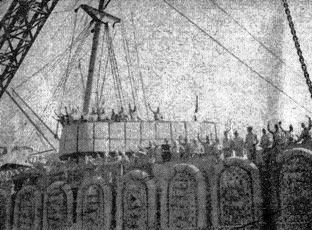 The troopship edges into the dock and happy soldiers wave as they wait eagerly to go ashore.
The troopship edges into the dock and happy soldiers wave as they wait eagerly to go ashore.
|
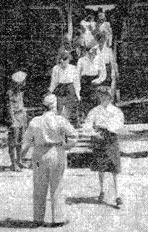 Nurses came, too, and they were among the first to disembark.
Nurses came, too, and they were among the first to disembark.
|
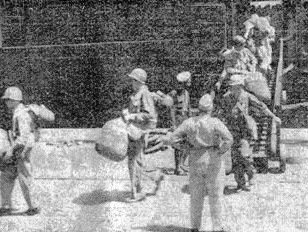 Steel-helmeted G.I.'s pack off their own gear. The weather was warm and they soon changed to cooler clothes.
Steel-helmeted G.I.'s pack off their own gear. The weather was warm and they soon changed to cooler clothes.
|
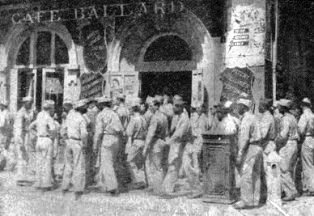 G.I.'s swarm the streets as they set out to see the town. Cafes and bars like this attracted many of them.
G.I.'s swarm the streets as they set out to see the town. Cafes and bars like this attracted many of them.
|
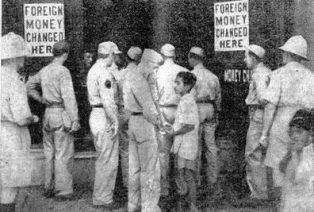 These fellows couldn't wait to get their money converted at the Army finance office, so they hiked to the nearest money changer.
These fellows couldn't wait to get their money converted at the Army finance office, so they hiked to the nearest money changer.
|
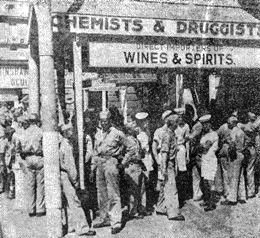 There's no alcoholic drinking on a troopship, and liquor stores did brisk business.
There's no alcoholic drinking on a troopship, and liquor stores did brisk business.
|
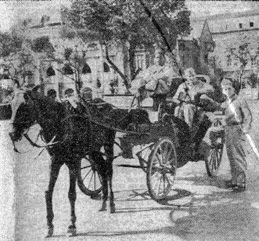 Some soldiers did their sight-seeing in gharries, as gas rationing makes taxi fares virtually prohibitive.
Some soldiers did their sight-seeing in gharries, as gas rationing makes taxi fares virtually prohibitive.
|
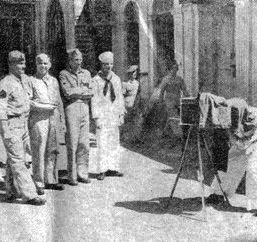 A picture from India to send to the folks. A U.S. sailor and three staff sergeants pose.
A picture from India to send to the folks. A U.S. sailor and three staff sergeants pose.
|
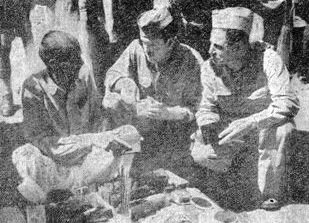 Indian currency is larger in size than U.S., so these privates buy wallets from a street vendor.
Indian currency is larger in size than U.S., so these privates buy wallets from a street vendor.
|
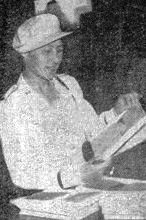 A newly-arrived Army nurse shops for silk stockings.
A newly-arrived Army nurse shops for silk stockings.
|
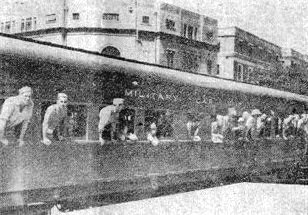 After seeing the town, troop trains take the fellows to their new stations. Anyway, they've had fun.
After seeing the town, troop trains take the fellows to their new stations. Anyway, they've had fun.
|

MORE TROOPS ARRIVE IN INDIA
Original April 8, 1943 issue of C.B.I. Roundup shared by Ruth Canney, widow of CBI veteran John Canney.
Background information for this page provided by CBI Veteran Carlton W. King.
Copyright © 2007 Carl Warren Weidenburner
SEE THE RECREATED ISSUE
TOP OF PAGE PRINT THIS PAGE ABOUT THIS PAGE SEND COMMENTS
CLOSE THIS WINDOW